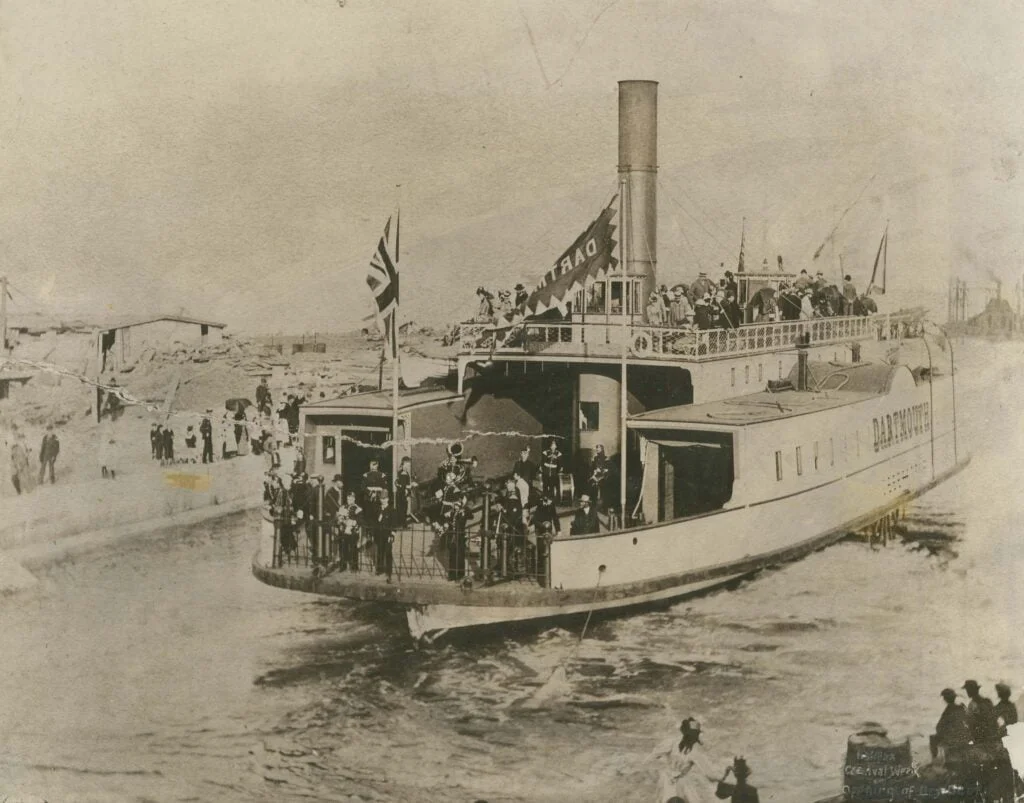From The Story of Dartmouth, by John P. Martin:
In 1888 George E. McDonald came to Dartmouth as lineman and agent of the Bell Telephone Co., and set up the Exchange in his residence at 19 Edward Street. There were then some 30 telephones in use, including one at the Town Hall and another at Chief of Police McKenzie’s house above the lock-up.
The latter instrument was mostly to receive fire calls. This innovation marked a great improvement over the established practice of messengers running on foot or galloping on horseback long distances whenever an alarm had to be sounded. Even after the fire-bell rang, disastrous delays often occurred because of the roundabout arrangements employed in moving the fire engine.
One night in February, for instance, Williams’ two-storey boat-shop was burnt to the ground. The building stood at the foot of Church Street which location is almost within shouting distance of the Engine House, and within pumping distance of the salt water. But the firemen were helpless because the engine was late. Investigation later revealed that the driver who raced to Greene’s stables near the foot of Quarrell Street, could not find the key to the harness room. Then the harness got tangled. Icy street conditions caused more delay. As a consequence, citizens began to murmur and to agitate that the Town should maintain its own horses near the Engine House.
The Council made a slight move in this respect by purchasing George Turnbull’s watering-cart for $35, but they still hired a horse and driver from Greene’s. The rate was $3 per day. The cart was filled with salt water from a tank on Moseley’s wharf, and also with fresh water supplied by the Starr Company from their stream.

The new Halifax and Dartmouth Steam Ferry Company seemed to be prospering. In 1888 they declared a dividend of 8%, and shortened the hours of their employees by engaging a third crew In that year also they acquired the first two-laned ferry. This was the paddle-wheeler “Dartmouth” built by the Burrell Johnson Company in Yarmouth at a cost of $30,000. Alongside the small one-laned ferries, this boat was a floating palace with her steam-heated electric-lighted cabins, commodious lanes for vehicles and a spacious upper deck. She became the popular steamer for picnics.
The first industrial establishment in Halifax or Dartmouth to be equipped with a private telegraph line was the Dartmouth Rope-works. In 1888 they had their office connected with wire by running a spur line from the vicinity of the foot of Jamieson street. One of the lady clerks did the telegraphing. Telephones were sometimes noisy and hence the telegraph was considered safer, especially in transmitting code words.
That summer the Ropeworks laid out George Street, and erected thereon nine identical houses known as the “Nine Sisters”. (The front design of some of these has since been altered.) John T. Walker was the Contractor, and George Mosher his foreman. The Company also laid out John Street, and Pelzant Street was to follow. They were taken over by the Town within the next few years.
Later in 1888 John T. Walker built “Glenwood” on the former Bell property (now 22 Main Street), for Warden James Simmonds. In the same neighborhood John R. Graham, the Dartmouth butcher, built the house on what was once part of Christian Bartlin’s grant, and is now the Creelman property at No. 5 Braemar Drive. A Halifax newspaper’s comment in describing the location of these new dwellings said that “they are on sites which some 25 years ago were occupied by the wigwams of [the Mi’kmaq].”
Also in 1888 Contractor A. G. Gates erected for Charles A. Robson the large dwelling at the southwest corner of Queen and Dundas Streets. Miss Ross had “Morven” cottage built at 46 Dahlia Street. Mrs. Thomas Creighton purchased the house previously built and occupied by Andrew Shiels at 114 Ochterloney Street. H. C. Walker, junior, put in Dartmouth’s first plate-glass window at his haberdashery store on the location of the Harbor Cafe. W. H. Greene leased from the Ferry the dwelling and stables vacated by W. H. Isnor who was moving his livery business to Halifax.

